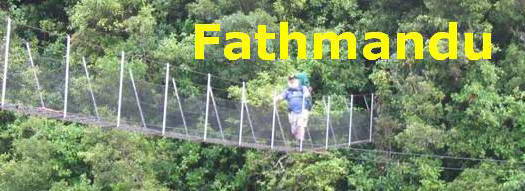
Many thanks for permission to use graphics from their software and toposheets |
 |
|
Woodhill DiaryMonday 21 April 2008 page 2 It's a gloriously sunny yet cool autumn day as we head south down the old gravel road with its thick carpet of needles. I suspect we're in horse territory but this is just exactly what I had in mind when I set out.
Small side roads suitable for horses head off towards the beach here and there. Inland there is a repaired fence and wiremesh Taranaki gates. At one point where an obvious off-road motor cycle route has headed up a bank, someone has dragged a large tree trunk across the path. Someone with some reasonably heavy lifting or dragging gear.
I'm enjoying striding out a bit today. It's loosening the one-sided lower back spasm that's been grabbing me for a day or two.
We pass a clearing or two where at one time, a large concrete tank has provided a water supply.
A nearby tap apppears to feed a pond which shows most of the characteristics of CHH forest management
Someone, however, has been busy with new road signage. Temu Rd heads back towards Inland Rd. I walked it a year or two back when decaying signs warned me to stay clear of forestry work which had finished months before.
Further down the road the plumbing evidently does not extend. The horse people operate a BYO policy.
Along this road are quite a few specimens of toru, (Persoonia toru), another one of Allan Cunningham's namings. It's a close relation of the Aussie proteas, which is pretty obvious, and also, though less obviously, of the rewarewa.
[STOP PRESS. These are not toru, though in some ways similar. I came back when they were in full bloom and the flowers are radically different. The most likely identification I can come up with is either Acacia longifolia, or possibly A. concurrens or A. auriculiformis, all of which have the characteristic tubular yellow flowers that toru does not have.] Mostly it's shrubby but an occasional biggy can be found here and there.
The walking is wonderful. Not the variety of scenery I'd get from a Waitakeres walk, but that's not what I'm after today.
Alice checks out a potential hazard. The plastic is just about falling apart brittle.
Here we are, and in quite good time. I drop the pack
get out the thermos and lean back with a cup of coffee and a biscuit.
That's the best view of the lot. The tips of the pine branches are silvered where they catch the light.
I suffer from a very mild form of tinnitus, which sounds like medium distance cicadas, and in the otherwise quiet, with a blue April sky above, it's a bit late for cicadas, but today they sound OK. Alice reckons we might just get on our way, so off we head back to the van. On the side of the road, you can see just how dry it's beem. These ferns are crisp, even with the recent rain.
We hit the green walking track signs, and decide to head back following the signs to see what's been doing walking track-wise behind the dunes.
Here's the big dune
A few metres further on, signs head off to the left around the big dune, but the path itself heads straight on.
There's a bunch of tauhinu in flower. I believe there was talk for a while of cultivating this commercially for a contraceptive pill precursor to be extracted from it. Never heard any more about it.
We appear to have run out of track, unless we head up the big dune ahead. We saw this one from the other side on the way out along the 4WD access road. I look for a route that does not involve climbing soft sand in walking sandals.
Where to now?
Ah... that looks like a possibility.
I pass a patch of sand that a few days ago would have been dry and apparently lifeless. After just a couple of days of rain and a little sun it is starting all over. If there is one thing that gives me hope for the future in the present climatic swing it is this basic natural instinct for life, for survival. (I'm just not so positive that it will be a form of life that includes us.) As Allan Esler points out in his book on Auckland botany, vegetation is a "becoming". There is no such thing as pasture or bush or scrub. It has always emerged from something previous and is always evolving into something new. We are not "preserving" something static called "the Waitakeres", for example. In fifty years it will all be different, as fifty years ago the bush around Arataki Visitors' Centre was mostly farm and scrub
We scrubcrash our way back to the access road, following a path made by something about the size of a large rat. Just up the way is another walking track sign. Now how did that get buried so deeply?
I come back later to see whether the walking track continues on the other side of the road. It doesn't. It heads back to the carpark via the 4WD access. So much for
And here's the van.
|
|